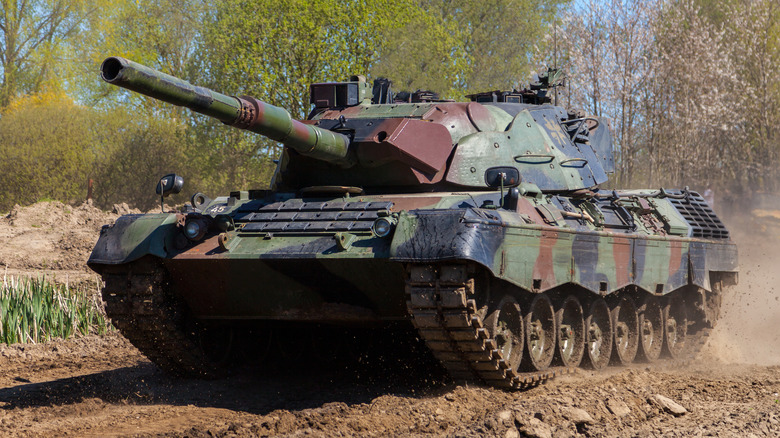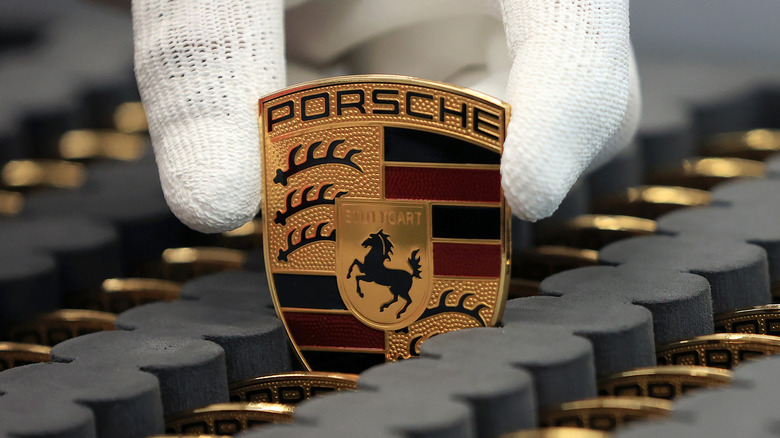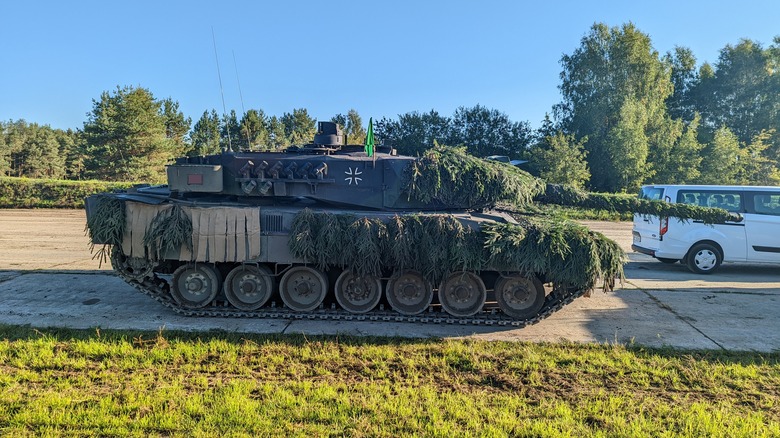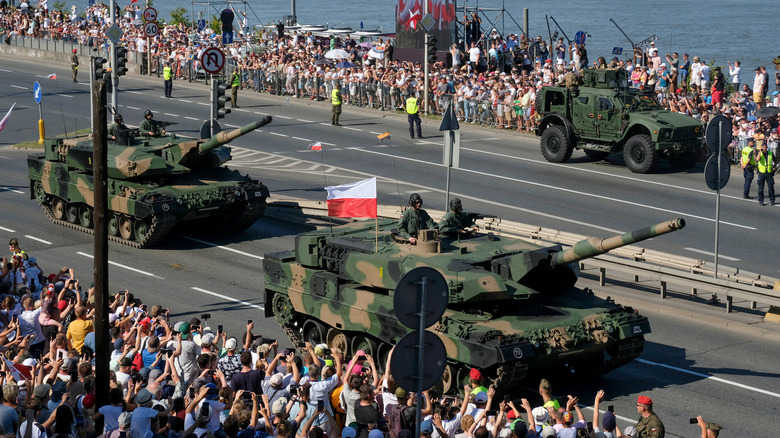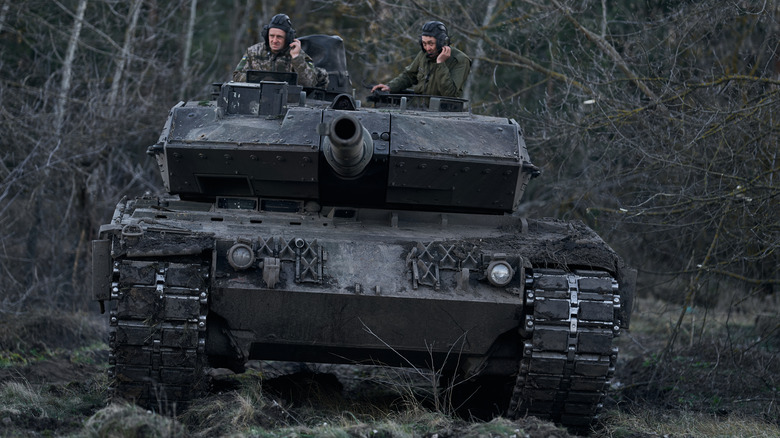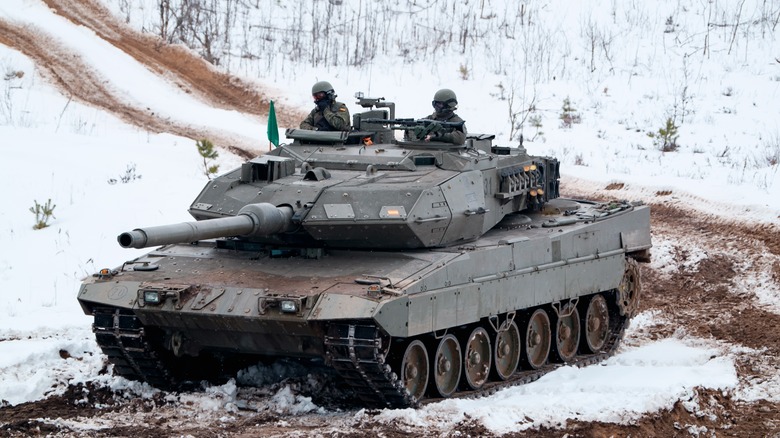Everything You Need To Know About The Leopard 2 Battle Tank
Despite being designed in the 1970s, the Leopard 2 battle tank is still widely in use today and plays a pivotal role in major international wars and other conflicts. There's a good reason for its longevity on battlefields across the globe — along with the American M1 Abrams, the German Leopard 2 is considered one of the most impressive tanks ever made. Originally manufactured for the West German army in the depths of the Cold War, the Leopard 2 can cover ground quickly over a wide range of terrain types and is adept against other armored enemies.
Over the past few decades, the Leopard 2 battle tank has gone through some design changes, both major and minor, but has consistently boasted impressive specs when it comes to both its engineering and armament. Notably, the Leopard 2 has since evolved from a German tank to a global one, as it's been exported to the armed forces of several different nations. Despite entering its 50th year of service, the Leopard 2 is still making headlines, as dozens of battle tanks have been sent to Ukraine to assist the nation in defending itself against Russian forces. Here is everything you need to know about the Leopard 2 battle tank.
Porsche was one of the first designers of the Leopard 2
West Germany first deployed the Leopard 1 — a medium tank — in 1965, but as the threat of war with the Soviet Union showed no signs of abating, it was decided that a tank with stronger armor was vital for the nation's defense. One of the first manufacturers commissioned to work on an upgrade to the vehicle was Porsche, along with Krauss‐Maffei Wegmann and Maschinenbau Kiel.
After a few hiccups during early development, the first two prototypes of the Leopard 2 were completed in 1972. Notably, the prototypes were tested not just on German terrain but also in other countries to see how the tank could stand up to both hot and cold environments, ensuring that it could be an all-weather, all-terrain versatile fighter. Several types of turrets and hulls were also tested during this development phase.
Incorporating performance requirements made by the United States (the leading nation in NATO) as well as a stronger hull and a 120 mm main gun on its turret, the prototype known as the Leopard 2AV was officially approved, with West Germany ordering 1,800 tanks in 1977. By the time it was fully adopted by the West German army in 1979, it was considered one of the most advanced tanks in the world. Over the years, the Leopard 2 has seen many modifications and advancements to modernize the tank, including modular armor, digital upgrades, and Hard Kill Active Protection against anti-tank weapons.
The Leopard 2 is fast and deadly
The Leopard 2 is often compared to the M1 Abrams as one of the most efficient tanks of all time, thanks to its combination of armor, weaponry, and mobility. When it first debuted, its compact motor — an MTU MB 873 Ka501 — was considered highly advanced and exceptional. Capable of generating 1,500 horsepower, the turbocharged diesel engine with an automatic transmission displaced 47.6 liters and made the Leopard 2 one of the fastest tanks, able to reach a maximum speed of 72 kilometers per hour.
It can be equipped with a deep wading kit that allows the tank to traverse water up to four meters deep. It can also maneuver trenches three meters deep and can handle gradients of 60% and side slopes of 30%. It has a 1.15-meter vertical step and a range of 550 kilometers.
The tank, which is 3.7 meters wide and 2.48 meters tall, has a four-person crew and is nearly 10 meters long when its gun is aimed forward. That main gun is a 120 mm Rheinmetall Rh-120 smoothbore tank gun, which can fire DM63 rounds across 4 km and reach twice that range with LAHAT anti-tank guided missiles. It can carry 42 rounds, as well as 4,750 rounds of 7.62 mm bullets for its twin machine guns. Of course, the tank can fire in any direction with a 360-degree traverse range and has an elevation range between -9 and +20 degrees.
Several nations still use the Leopard 2
Since its development, Germany has added around 2,125 Leopard 2 tanks to its arsenal. After the reunification of West Germany and East Germany, many of the tanks were sold to other countries at a discount as Germany sought to reduce its armed forces — spreading the use of the Leopard 2 around Europe and beyond in the 1990s. Today, Germany still operates more Leopard 2 tanks than any other nation, but over a dozen countries also use the proven battle vehicle.
Countries currently deploying the Leopard 2 include Greece, Spain, Turkey, Poland, Finland, Switzerland, Sweden, Austria, Hungary, Denmark, Portugal, Norway, Slovakia, Czechia, and Canada. So many Leopard 2 tanks were exported to European nations that the manufacturer even started calling it the "Euro Leopard," although several countries — like the U.K. and France — still use their own tanks.
The Leopard 2 has operated in several major conflicts around the world over the past few decades, including in the 1990s, when Germany used it for peacekeeping missions during the Kosovo War. It's also been used by multiple nations, including Canada, Denmark, and the Netherlands, during the War in Afghanistan in the first two decades of the 21st century. Turkey also deployed the tank to Syria in the 2010s. Notably, the Leopard 2 has been in recent news headlines, as it's become part of one of the biggest armed conflicts of the 2020s — the Russo-Ukrainian War.
Several Leopard 2 tanks have been destroyed in the Russo-Ukrainian War
Since being invaded in 2022, Ukraine has received military aid from several nations to help its war against Russia, including both financial support and supplies of weapons and other defensive equipment. However, Ukrainian President Volodymyr Zelenskyy made it clear that his nation needed something in particular to survive the conflict — tanks. Regarding previous support Ukraine had already received after months of fighting, President Zelenskyy said in 2023, "I can thank you hundreds of times ... but hundreds of 'thank you' are not hundreds of tanks."
Though Ukraine had hoped for hundreds of tanks to be donated to their cause, initially, Germany sent 14 of its Leopard 2s. Since then, Ukraine has received over a hundred more, including from other nations like Spain and Canada, as well as other advanced battle tanks, like the M1 Abrams. It took some time for Ukrainian soldiers to be trained on the tanks, but they soon entered battle.
While the war has involved countless air strikes and some fighting on the Black Sea, much of the conflict is over land, where tanks are an invaluable resource to both sides. The mobility, firepower, and effectiveness of the Leopard 2 make it especially useful over both the urban and the rough, wooded terrain that makes up large portions of the battlefield between Russian and Ukrainian forces.
Several Leopard 2s have already been destroyed since deploying in Ukraine, to the point where the country is now relying more and more on cheaper, less formidable tanks. This has also made Germany and other countries more reluctant to send more, and — as the deadly and costly war enters its third year — it's unclear what the future for the Leopard 2 in the conflict will be.
The future of the Leopard 2
If the Russo-Ukrainian War hasn't already made it clear, the Leopard 2 isn't going anywhere. Countries are still putting in orders for dozens, if not hundreds, of Leopard 2 tanks for their armed forces, such as Norway, which ordered 54 tanks last year. Even Italy, which had previously not used the Leopard 2, has ordered 250, expected to be delivered as late as 2026. Despite being first developed in 1972, its design has proven resilient and effective enough to last decades, especially with modern upgrades.
However, nothing lasts forever. In 2015, Germany announced it was designing a next-generation Main Ground Combat System (MGCS) — in conjunction with France — that would serve as a successor to the Leopard 2. Just as the Leopard 2 took over a decade of development to deploy after the Leopard 1, this new tank — which has casually, but not officially, been called the Leopard 3 — is still a few years off.
One big upgrade the next-gen tank may have is an automated gun turret, as AI and other digital technology rapidly advance. Current estimates place the Leopard 2 being retired sometime in the 2030s, though the escalation of armed conflict in Europe may change that date. The invasion of Ukraine has shown political leaders both the need to modernize their armies as well as the need to get the most out of what they currently have.
At some point, the Leopard 2 tank will inevitably be made obsolete by the advanced technology of successive armored vehicles. But, for now, despite being over 50 years old, the Leopard 2 is still one of the best military tanks in the world.
